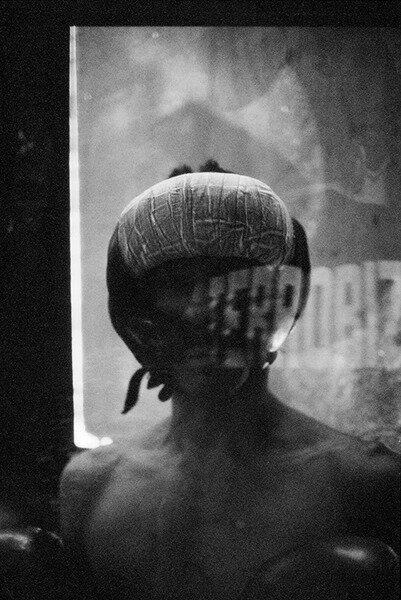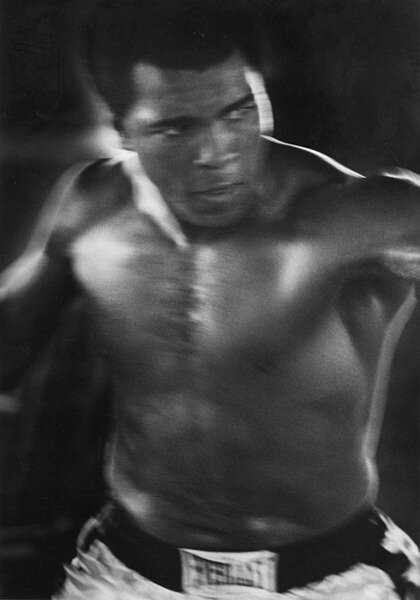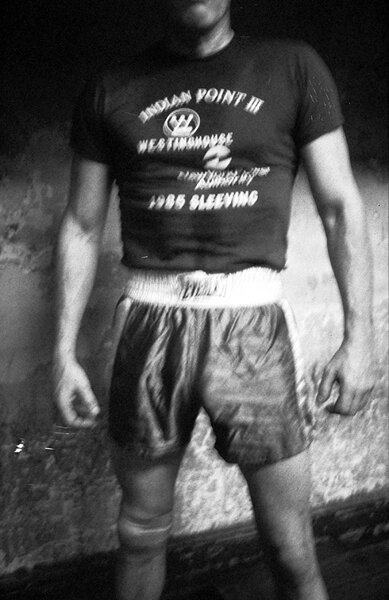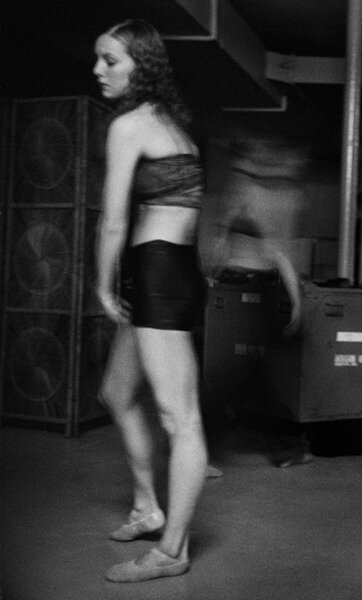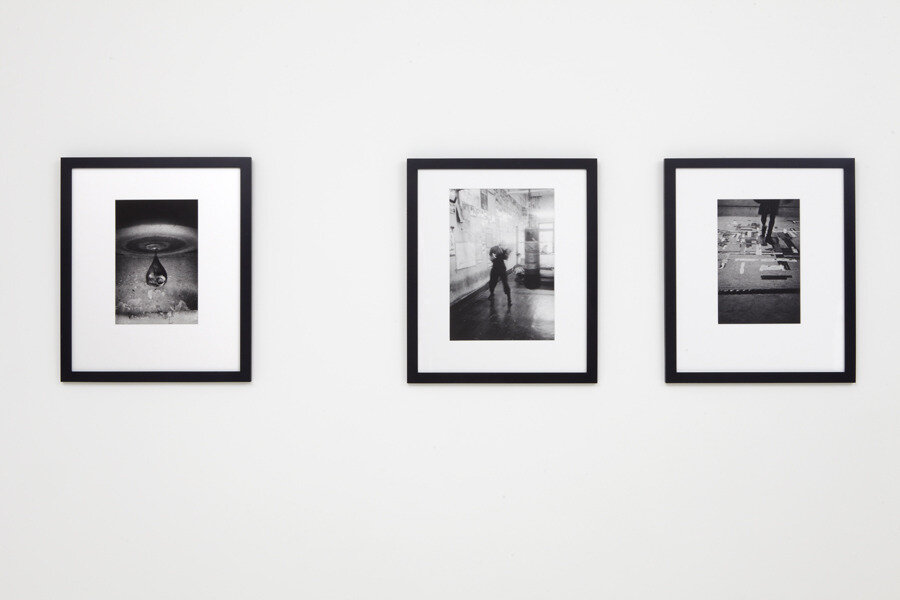John Goodman’s camera [however] is not an instrument of detachment, analysis, or judgment, but an iris of an eye that is our own, dissolving ostensible barriers between object and subject. His intention is to make us feel, and not merely see, the world of the Times Square Gym.
— Joyce Carol Oates
The photographer John Goodman is infatuated with the human body, its contradictions, and how it moves. Goodman states “I explore the contest between light and dark, power and grace, grit and tenderness.
Boxers + Ballerinas, his long awaited first solo exhibition in New York, demonstrates the extremes of what bodies can endure. In this evocative show, Goodman pairs his boxing photographs from the acclaimed monograph, The Times Square Gym (Introduction by Pete Hamill, Evan Publishing, 1997) with a 2004 backstage photo essay of dancers of the Boston Ballet. No greater contrast in purpose exists in human locomotion. Goodman avoids the brutal confrontation of boxers in the ring but rather wisely creates a character of The Times Square Gym itself, a legendary New York institution where boxers both known and unknown have trained side by side for decades. Now defunct, (the offices of Condé Nast would rise from its ashes) the gym was managed by the tireless and compassionate Jimmy Glenn who rode it through twenty years of daily training regimens. Today, Glenn is best known as the owner of Jimmy ‘s Corner, a beloved bar located in the heart of Times Square that is one of the last vestiges of old New York. Goodman photographed the gym during the last 18 months of its existence. He treats the exterior like a portrait. Its grimy New York-worn concrete skin seems to bear the bruises and battered cheeks of its occupants. It is the face of Job, while the gym’s interior circulates crusaders throughout its halls and on its mats like blood, pumping and giving it life.
The Boston Ballet dancers that Goodman photographed backstage as they prepare for their performance exude their own contradictions. At once corporeal and otherworldly, they share in the sweat and exertion of the fighters and sometimes they too appear like warriors in battle. Mostly, however, their expected grace in motility is conveyed in the gritty and graphic manner of Goodman’s monochrome printing. These ballerinas are magical - as all ballerinas should be - formed by the photographer’s eye and his belief that angels can’t be photographed but their halos can.
Both bodies of work are shadowgraphs: pictures of fleeting figures that confirm our desired voyeurism of talent, our need to witness greatness beyond the everyday, to examine without the distraction of speed, skill or amazement. Boxers rarely reach the level of public recognition (thousands fight, few shine); most ballerinas are merely pawns in a choreographer’s plan for an art that exists for milliseconds. In both cases, Goodman salvages them, rectifies them from their instant demise. These are photographs of mortals fortifying life. In his essay in The Times Square Gym book Pete Hamill writes: … "The Times Square Gym ... represents that rarest of artistic achievements: a monumental homage to the lower working class. Its poignancy owes to its unflinching lack of sentimentality." Duane Michals compares the book to Alexey Brodovitch’s book Ballet “in the way that it captures the atmosphere of the boxer’s world – you can almost heard the thud of the gloves hitting each other and smell the smoke and perspiration."
A student of Minor White, John Goodman is a photographer of great range and capability. Whether documenting the dark underbelly of Boston’s infamous Combat Zone or the streets of Havana, he conveys certitude of purpose and effect resulting in photographs that transcend the impact of reality. Goodman’s work has been shown in numerous solo and group exhibitions, among them Naked Before the Camera at the Metropolitan Museum of Art (2012), Exposed at the Tate Modern, London (2010), and Echo at the Howard Yezerski Gallery in Boston (2012). His photographs are in the permanent collections of the Art Institute of Chicago, Fogg Art Museum at Harvard University, the Metropolitan Museum of Art, Museum of Fine Arts, Boston, and the San Francisco Museum of Modern Art. His work has appeared in New York Times Magazine, Vanity Fair, Esquire, Rolling Stone, and Goodman has shot advertising campaigns for Gucci, the Gap, Converse and Reebok. He is on the faculty of Lesley University College of Art and Design, and is an instructor at the Maine Media Workshops in Rockport, Maine.
All works © John Goodman.
Exhibited Works
Goodbye/ The Times Square Gym, 1996
Selenium toned gelatin silver print
15 x 10 inches (38.1 x 25.4 cm) Image
Solataire/ The Times Square Gym, 1993
Selenium toned gelatin silver print
15 x 10 inches (38.1 x 25.4 cm)
Terrorize/ The Times Square Gym, 1998
Selenium toned gelatin silver print
15 x 10 inches (38.1 x 25.4 cm)
Eddie/ The Times Square Gym, 1993
Selenium toned gelatin silver print
15 x 10 inches (38.1 x 25.4 cm)
The Universe/ The Times Square Gym, 1993
Selenium toned gelatin silver print
15 x 10 inches (38.1 x 25.4 cm)
Gene Boynton/ The Times Square Gym, 1993
Selenium toned gelatin silver print
15 x 10 inches (38.1 x 25.4 cm)
Tuxedo Couple/ The Times Square Gym, 1993
Selenium toned gelatin silver print
15 x 10 inches (38.1 x 25.4 cm)
Hood Up/ The Times Square Gym, 1993
Selenium toned gelatin silver print
15 x 10 inches (38.1 x 25.4 cm)
Exterior/ The Times Square Gym, 1993
Selenium toned gelatin silver print
15 x 10 inches (38.1 x 25.4 cm)
Muhammad Ali/ The Times Square Gym, 1976
Selenium toned gelatin silver print
15 x 10 inches (38.1 x 25.4 cm)
Anthony Greene/ The Times Square Gym, 1996
Selenium toned gelatin silver print
15 x 10 inches (38.1 x 25.4 cm)
Ballerina/ Boston Ballet, 2004
Selenium toned gelatin silver print
18 x 12 inches (45.7 x 30.5 cm)
Echo/ Boston Ballet, 2004
Selenium toned gelatin silver print
18 x 12 inches (45.7 x 30.5 cm)
Elysia Fridkin/ Swan Lake/ Boston Ballet, 2004
Selenium toned gelatin silver print
18 x 12 inches (45.7 x 30.5 cm)
Enter La Sylphide/ Boston Ballet, 2005
Selenium toned gelatin silver print
18 x 12 inches (45.7 x 30.5 cm)
Francine 2/ The Times Square Gym, 1993
Selenium toned gelatin silver print
15 x 10 inches (38.1 x 25.4 cm)
Gene Samuels 2/ The Times Square Gym, 1993
Selenium toned gelatin silver print
15 x 10 inches (38.1 x 25.4 cm)
Gene Boynton 2/ The Times Square Gym, 1993
Selenium toned gelatin silver print
15 x 10 inches (38.1 x 25.4 cm)
Larissa Ponomarenko/ Boston Ballet, 2004
Selenium toned gelatin silver print
18 x 12 inches (45.7 x 30.5 cm)
Odette/ Swan Lake/ Boston Ballet, 2004
Selenium toned gelatin silver print
18 x 12 inches (45.7 x 30.5 cm)
Raw Dance/ Boston Ballet, 2005
Selenium toned gelatin silver print
18 x 12 inches (45.7 x 30.5 cm)
Ring/ The Times Square Gym, 1993
Selenium toned gelatin silver print
15 x 10 inches (38.1 x 25.4 cm)
Sleeping Beauty/ Boston Ballet 2004
Selenium toned gelatin silver print
31 3/4 x 14 3/4 inches (55.2 x 37.5 cm)
Times Square Gym Interior, 1993
Selenium toned gelatin silver print
12 1/4 x 18 1/2 inches (31.1 x 47 cm) Image
Untitled 2/ The Times Square Gym, 1993
Selenium toned gelatin silver print
12 1/4 x 18 1/2 inches (31.1 x 47 cm) Image
Installation Views





